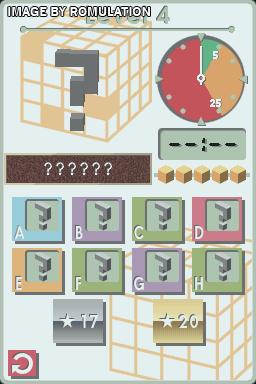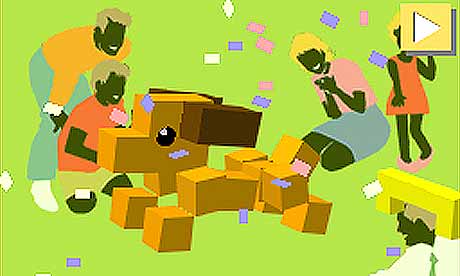Ah, something easy for a change. A quick review! Alright, I’m gonna enjoy doing this. Wait, it’s a puzzle game? Alright fine, I’ll find a way to make this interesting.
Have you ever played Picross, or Nonograms? Or
Pic-A-Pix? It’s all the same, really. Some Japanese logic games have a whole
bunch of different names, like Sudoku, which can also be called…. Um… Number
Place, and… Um… That Stupid Puzzle We’re Getting Flooded By? Okay, never mind.
Picross is one of dozens of logic puzzles that involve grids, clues and numbers,
with more being invented as we speak. Maybe you’ve seen the rise of the logic
game Binero recently.
Picross puzzles are a fairly simple concept, but getting the
hang of them is harder than it seems. And, of course, the bigger the puzzle,
the harder it might get. You begin with an empty grid, preferably with a height
and length divisible by 5 (but that’s not a necessity), and clues on top (for
the vertical lines) and on the left (for the horizontal lines). The clues are
numbers, and on a line, each number represents a block of squares to be
blackened in the grid. If the clue is 1, you blacken only one square. However,
there’s at least one white square separating each block of black squares (but it could be more than one white square). One or more, and the tricky part is to figure out where the
black blocks are and how many white squares separate them. And of course, just
like Sudoku, there are many ways to solve puzzles like this. Here’s an example
of a grid being solved.
The line at the bottom has question marks because you
can’t deduce any black squares at the moment. However, if we had the clues for
the columns, maybe it would be possible to spot one or more of them. Oh, and of
course, this doesn’t cover the variations: Color Picross, Triangular Picross,
that horrible secondary mode in Pokémon Picross that has clues covering two
lines or columns… Oh, I’ll get to that one someday. Today’s game contains a
variation on the Picross formula… and in case you forgot the title of this
article already, it’s Picross 3D, so instead of facing grids with just height
and length, we’ll also have width to take into consideration. It’s a
block-smashing adventure for everyone who likes puzzles!
And who will explain these new mechanics to you? Cube
Thing, of course! Alright fine, this game’s mascot doesn’t have a name… as far
as I know. It’s just some kind of yellow cube with two tiny cube hands, two
eyes, and a… mouth? An orange mouth? I don’t know, but if the goal was to
create a minimalistic character that is still appealing, it’s a failure, the
thing can be actually kinda creepy. Especially since it can move around and stretch
itself; thankfully, it only appears on menu screens and on some unlockable
animations. With its two different eyes, this thing looks like it was thought
up by Pablo Picasso, drawn by Andy Warhol in the middle of his soup cans era
(or perhaps his Taylor Mead’s Ass
era), and then given depth by the pioneers of 3D animation. I realize that’s
more of a compliment than an insult… whoops.
-9.jpg) |
| Run, run, run! After this exercise you'll be stuck working in a tiny cubicle! |
-6.jpg) |
| Well... at least the 0s are easy. |
Confused yet? Don’t worry, the confusion ends here. Well,
I think it does. If your head implodes further down the line from information
overload while reading this article, go see a doctor immediately.
The Tutorial section teaches a few more important
details: You move the blocky construction around with the stylus. When the time comes to
paint a block, you hold Right on the D-pad and then tap the block; do that only
when you’re certain that a block will stay in the final sculpture. And if you
want to break a block, you press Up and tap the block you want to break. If you
break an incorrect block, you’ll get a NO!, lose a life (you have 5 lives), and
the block will reappear, repaired and colored, and you can keep going. Have fun
making these basic Minecraftian sculptures out of cubes!
From this point on, levels are split between
difficulties (Tutorial, Easy, Normal, Hard). The last “Random” option lets you
pick a level at random among difficulties, with a set number of “lives”, and
with how much time you get to solve it. And things stay pretty much the same
all the way through. The Easy, Normal and Hard sections are split in 10
“levels” which are themselves split into 10 “puzzles”, 8 of which you must
solve and 2 that you unlock when you get a certain number of Stars on that
level-wait, Stars?
 |
| Each puzzle here can give you 3 stars, except the Silver and Gold ones. |
Oh, but that’s not all. The “worlds” split in 10 “levels”
also include a number of bonus levels with additional challenges:
-One Chance: You have only one life to complete this
puzzle. Gee, almost sounds like that third star, except obligatory.
-Timer: You’re given a very short amount of time to
complete a puzzle, but as you smash blocks that time increases, giving you more
time to complete the puzzle. You snooze, you lose, but who would snooze in the
middle of a puzzle game anyway? …Probably all the FPS fans out there…
-Builder: You’re given multiple puzzles to solve, each
of which is a piece of a larger creation. As an example, the first one is split
in 5 pieces and forms an antique car when completed. The last (and in my
opinion, hardest), is a giant dinosaur skeleton.
This means there’s over 300 puzzles to complete. This
should satisfy all your Picross 3D needs for a while, needs you probably didn’t
even knew you had. Hell, when I started playing that game, I didn’t know I had
those needs. I had played many, many grids of normal, 2D Picross, but when I
bought the game, I was intrigued, then uncertain, then hooked. There’s
something oddly addictive about saving blocks, breaking blocks, and making
sculptures out of blocks. Then again, any Minecraft fan could have told me
that.
 |
| Run, puppy, run! Chase the ball! ...I mean, the cube! |
But wait, there’s more! The main menu also has the “My
Picross” Option, which lets you create your own puzzles: you just build the
sculpture with blocks and the game then assigns clues to some of the lines and
columns. After which you can trade those puzzles with other owners of Picross
3D (Good luck finding them, though!). Back when the Nintendo W-Fi Connection was
active for DS games, you could also send those puzzles out to contests held by
the developers at HAL Laboratory, each with a theme. Even better, you could
download packs of new puzzles made by the developers, and by other Nintendo
staff. You could download over 200 more puzzles that way (since I was lucky
enough to get this game before the Wi-Fi Connection was terminated, I have 240
puzzles in that bank – and even then, I deleted the smaller puzzles that were
so simple to solve, so I should have more).
 |
| Guess we need something to push all the unnecessary blocks away. |
However, the bigger the puzzle the longer it will be
to solve, so on the final difficulty you can spend anywhere from 5 to 30
minutes solving puzzles – and that’s if you can quickly make the logical
connections between the clues. Some puzzles are still so difficult that you can
need 40, 50 minutes… This is not the game to pick up if you want
something that is done fast. Also of note, as much as I enjoy the concept, the
button configuration can be a little troublesome, as you need to keep a thumb
on Up or Right on the directional pad as you tap on the screen, and sometimes that
finger has to stay there for a while. It’s nitpicking, but now that I’m playing
on a Nintendo 3DS (and I largely prefer the D-pad to the Circle Pad), it’s a
bit of a problem. Also, the game says you can use the L and R buttons, but for
some reason this wasn’t working for me.
The removal of the Nintendo Wi-Fi Connection really
took out a lot of fun features. Thankfully, a sequel was made for the Nintendo
3DS, titled Rittai Picross 2 in Japan, came out in October 2015. I suggest that
you look for it.
Another issue I have with the game, a more important
one, is about the harder puzzles in this collection. One of the key elements of
Picross is that nothing is supposed to be left to chance. The clues are
precise, and the combination of black squares and empty squares (marked to make
sure you don’t paint them black later accidentally) makes it so that you never
have to “guess”. The puzzle can be as hard as can be, but in the end there is
always a way to find the answer despite the difficulty. Some puzzles in Picross
3D, however, can be very tricky. They don’t exactly leave things to chance, but
sometimes it feels as though the harder puzzles lack a few clues that would
allow you to complete them without having to guess. As an example, imagine a
row of 5 blocks, which indicates a 2 in a circle (thus two blocks of 1,
separated by at least 1 white [broken] block), and neither the clues in the
perpendicular rows or in the columns above help in any way, even when you’re
close to completing the puzzle. It’s like there’s that little thing missing.
Some other Picross games, such as Pokémon Picross, give “special abilities” in
order to help the player when in a tight spot like this, but Picross 3D offers
no such thing.
Last but not least, the “Minimum time” required for
some of the later puzzles is almost ridiculous in how short it is. Solving a
large puzzle in 10 minutes? It’s possible, but sometimes you practically need
to know the final cube construct right down to the detail in order to make that
work. And even with that, it’s not always simple. And so you even need to be
ridiculously quick in order to get those last lousy stars required to beat the
game.
Oh, also I don’t really like Cube Thing, but you could
probably have guessed that.
Okay, that’s all I had to say about this one! What’s
awaiting next week? Ah yes, a review of a Wii game, once again! I hope I’m gonna
find something fun to review.






No comments:
Post a Comment